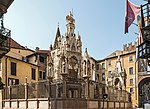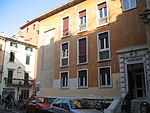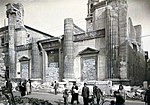Santa Maria di Chiavica, Verona
Italian church stubsRenaissance architecture in VeronaRoman Catholic churches in VeronaRomanesque architecture in Verona

Santa Maria in Chiavica is a former Roman Catholic church, now deconsecrated, in the Renaissance style, located on Via S. Maria in Chiavica number 7 in central Verona, region of Veneto, Italy. The building retains portions of its original Romanesque structure and original fresco and altar decoration, but is now used for theatrical and musical performances.
Excerpt from the Wikipedia article Santa Maria di Chiavica, Verona (License: CC BY-SA 3.0, Authors, Images).Santa Maria di Chiavica, Verona
Via Santa Maria in Chiavica, Verona Veronetta
Geographical coordinates (GPS) Address Nearby Places Show on map
Geographical coordinates (GPS)
| Latitude | Longitude |
|---|---|
| N 45.444222222222 ° | E 10.99975 ° |
Address
Via Santa Maria in Chiavica 7
37121 Verona, Veronetta
Veneto, Italy
Open on Google Maps











